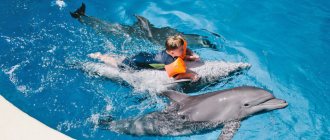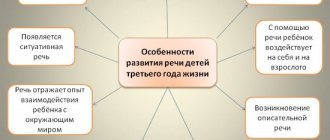Forms of motor alalia in children
Depending on the location of the brain damage, the following types of motor alalia are distinguished: afferent and efferent.
Afferent (kinesthetic)
This form is caused by damage to the area of the cortex that is responsible for the kinesthetic control of the speech program. It is located in the inferior parietal region of the left hemisphere. At the same time, it is difficult for the child to reproduce words and sentences and find articulatory poses. That is, the baby does not know how to position his tongue, lips, teeth when pronouncing a word.
The condition is called oral-articulatory apraxia. Outwardly, it manifests itself by replacing sounds and distorting the structure of syllables.
Efferent (kinetic)
Efferent motor alalia develops due to damage to Broca's center - the posterior frontal areas of the brain. This zone is responsible for controlling the switching of articulatory acts. Children with this pathology find it difficult to follow the sequence of speech movements. As a result, the syllabic composition of the word is distorted, and speech slows down. In science, this syndrome is called kinetic apraxia.
There are also levels of motor alalia. This classification takes into account the degree of speech underdevelopment. At level 1, the baby is extremely limited, uses a few everyday words, and the basis of speech is onomatopoeia and babble. Level 2 is characterized by a wider range of words and the ability to compose short sentences. Level 3 of motor alalia is distinguished by the presence of phrasal speech.
Silent child. Alalia
Home — About speech therapy — Silent child. Alalia
Every family eagerly awaits their child's first words. But time passes, and there are almost no words. Or they are there, but they are so illegible and there are so few of them that the family begins to worry. Parents go to specialists and hear: “Your child has alalia.” The term sounds scary and incomprehensible. Let's figure out together what it is.
Each child is unique, so the baby does not always fit into standard developmental norms (when he walked, he began to eat himself with a spoon, he started talking). But, nevertheless, there are a number of alarming factors that should be paid attention to
- this is the so-called “red flag”:
1 year: no babbling, the child does not point to objects and does not communicate with gestures.
1 year and 3 months - does not look at toys, does not show objects and people by name to parents (normally 5-10).
1 year and 5 months - still no first words.
1 year and 6 months - the child does not say “daddy, mommy”, cannot follow simple instructions (smile, raise your hand, etc.).
2 years - does not show body parts, speech contains less than 20 words.
2 years and 5 months - does not answer questions, does not use two-word sentences (Example: mom is walking, let's go for a walk).
3 years old - does not understand prepositions and many verbs, cannot follow two-step instructions (Example: take the typewriter, and now give it to dad), speech has less than 200 words.
If a child has similar disorders, then you should contact a specialist as soon as possible, because Perhaps he has a speech delay of the alalia type.
Alalia
– a speech disorder, which manifests itself in the absence or underdevelopment of speech due to damage to the speech areas of the brain during fetal development or at an early age. In this case, all components of speech are disrupted: sound pronunciation and syllabic structure, phonemic perception, vocabulary and grammar of the native language, coherent speech. This diagnosis can only be made by a doctor (psychiatrist or neurologist) when the child reaches three years of age. Until this time, we are talking about delayed speech development.
Causes
, which can cause alalia are varied. They can act from the moment when the baby is still developing in the mother’s stomach, and until his third birthday.
Alalia is varied in its manifestations: from simple verbal awkwardness to a complete inability to speak and understand spoken speech. There are different approaches; traditionally, they distinguish between sensory (impressive) and motor (expressive) alalia.
Sensory alalia is a disorder of speech understanding that is caused by damage to the temporal lobe of the brain (Wernicke's center). With this type of alalia, the child hears (physical hearing is preserved), but does not understand spoken speech. There are few children with this diagnosis. Identifying and distinguishing sensory alalia from other disorders (for example, early childhood autism, mental retardation, etc.) is difficult.
To better understand how a child with sensory alalia hears speech, imagine that you are in another country, for example, in China. Everyone around you is talking, asking questions, but you don’t understand anything. There is a gap between the meaning/meaning of the word and its “sound shell”, i.e. native speech sounds like a foreign one. All sounds are perceived as a “heap”, speech merges with the surrounding noise.
Children with sensory alalia are characterized by unstable reactions to sounds, i.e. The baby can recognize the speech of his loved ones and not react to the speech of strangers. And if various interferences appear during speech (extraneous noise, the appearance of new people), then these difficulties are aggravated even more. In addition, many children have difficulty distinguishing everyday sounds (Example: what sounds, a hair dryer or a refrigerator?), determining the source and direction of the sound.
Therefore, diagnosis is very important, to separate children with sensory alalia from other children with similar manifestations (autism, hearing loss, etc.) in order to correctly select the types of help and successfully overcome this complex disorder.
Motor alalia
– this is a systemic underdevelopment of speech, in which the child experiences difficulties in constructing an independent speech utterance, while the understanding of addressed speech is relatively intact. This type of alalia is also caused by damage to the parts of the cerebral cortex that are responsible for the motor production of speech. This type of alalia is divided into two forms: afferent and efferent.
Afferent motor alalia is caused by damage to the parietal cortex of the left hemisphere of the brain. This department is responsible for assessing sensations during the speech process: with the help of what movements this or that sound is produced, where we direct the breath at this time, etc. Awareness of this helps to build speech motor complexes, that is, a series of movements to pronounce a certain sound. A child with this form of motor alalia experiences difficulties in constructing these motor programs, since he does not feel the position of the organs of articulation (lips, tongue) and therefore often replaces sounds or does not pronounce them at all. For example, instead of the sound “y” one hears a vague “iy”, instead of “tyu” - “syu”, “gu” - “bu”, etc. That is, sounds are replaced even by ones that are distant in sound and articulation. The syllabic structure is certainly broken: for example, instead of “give” - “da”, “porridge” - “ka”, instead of “car” - “bi”, “ride” is also “bi”, that is, they call different words in one word .. It is difficult for such children to reproduce and remember articulatory patterns even with the help of an adult.
Motor efferent alalia is a consequence of damage to the frontal parts of the cerebral cortex (Broca's center), which combine sounds, words, sentences from individual articulatory movements and “verify” this sequence. Children with this form of motor alalia experience difficulties in transitioning from one sound to another and in reproducing the correct syllable sequence. For example, “sem” instead of “seven”, “khonona” is “good”, “shomasa” is “study”, the speech of such a child is incomprehensible to a stranger. and so on. Difficulties in the transition from one syllable to another are manifested in pauses: “Pa pu is called I go r” and in repetitions of syllables: “found fingers” - found a finger. There are agrammatisms in speech; when asked how old you are, the answer is “five” - five. This form of alalia occurs 9-10 times more often than the afferent one.
To imagine what the speech of a child with motor alalia sounds like, we will give an excerpt from the recording of the boy Vanya (4 years and 11 months), he was telling a turnip fairy tale: “Vyaasa...vyasa. Ani her... tinui-tinui, and couldn’t, and couldn’t make it. Basai ani...ai...zais...mysku...toss." A rough translation sounds like this: “They pulled and pulled, but couldn’t, and didn’t make it. They abandoned her. The hare and the mouse too.” As you can see, for a child who is almost 5 years old, this fairy tale is not so easy to understand or retell.
To summarize, afferent motor alalia manifests itself in difficulties in constructing speech movements, and efferent in difficulties in constructing a sequence of sounds, in combining sounds into words.
In addition to speech manifestations, most children with motor alalia are characterized by motor disorders and an insufficient level of development of fine and gross motor skills. Such children have difficulty fastening buttons and tying shoes; assembling puzzles, appliqués, and modeling also cause difficulties.
Children with alalia get tired quickly, their attention is exhausted, and their perception is fragmented.
Alalia
- this is a speech disorder, the correction of which is carried out not only by a speech therapist, but also by a doctor and a psychologist. A psychiatrist and neurologist will select appropriate drug treatment. The psychologist will deal with the correction and development of mental functions such as perception, attention, thinking. Only an integrated approach will help you “cope” with alalia. This work is lengthy, but it is often possible to achieve verbal communication of the child.
The content of the work is determined individually and depends on the child’s speech capabilities. Sometimes children with alalia do not have basic eye contact, i.e. they simply do not look at the speaker and do not engage in communication. Then the goals and objectives of the work will begin not with the challenge of speech, but with deeper goals - with establishing eye contact, with attracting the child’s attention to the teacher’s speech, with the ability to imitate simple movements upon request, etc. Just as each child is unique, so are the methods of working with alalik. Their speech therapist selects them individually for each child.
Alalia is a complex speech diagnosis. Its correction takes a long time (from several months, in rare cases, to several years) and requires comprehensive assistance: doctors, psychologists, speech therapists. The best age to start working is 3-4 years, when children develop a thirst for knowledge and self-criticism. Based on this, we can talk about the need for early diagnosis, because the earlier alalia is detected, the more time remains for corrective work and the less chance of developing secondary intellectual defects.
Share:
Find out more about the Center's services and sign up for a consultation or lesson
You can call (812)
640-90-77
, or by filling out the form below.
Causes of motor alalia in a child
The development of motor alalia occurs due to damage to the motor centers of speech in the brain.
Depending on the time of exposure to the traumatic factor, there are:
- Prenatal factors are those that affect the fetus. This group includes infectious diseases of women during pregnancy (rubella, cytomegalovirus infection, toxoplasmosis are especially dangerous), diabetes mellitus, toxicosis, incompatibility of the fetus and mother according to the Rh factor, hypoxia. Brain damage can also be caused by severe stress, physical trauma of a woman, taking medications that are contraindicated during this period, taking alcohol and drugs, smoking;
- Intranatal factors are those that act during childbirth. These include birth injuries to the brain and asphyxia. These factors lead to the death of neurons. Stimulation of labor, rapid labor, the use of obstetric forceps, premature rupture of water, premature placental abruption, and entanglement of the umbilical cord have a negative impact;
- Early postnatal factors. This group includes traumatic brain injuries, meningitis, encephalitis, and brain tumors that occurred in the first year of a child’s life. Infectious diseases, anemia, rickets, and malnutrition can also have an effect. A special role is played by a lack of communication, attention from parents, and emotional upheavals at an early age (separation from mother, for example).
A characteristic feature: the earlier and longer the negative factor was exposed, the more pronounced the motor alalia, the more serious the consequences and the more complex the prognosis.
Main reasons
The causes of the disease can be:
- Pathology of intrauterine development: maternal illnesses, injuries;
- Genetic predisposition;
- Complications during childbirth: hypoxia, infection;
- Head injuries;
- Poisoning with toxic substances.
Risk factors for the development of motor alalia may be frequent illnesses in children in the first years of life, surgical interventions under general anesthesia, insufficient speech contacts, as well as pedagogical neglect.
Signs of motor alalia in children
Symptoms vary in severity: from minor difficulties that practically do not interfere with normal life, to a complete absence of spoken language. Both the phonetic-phonemic and lexical-grammatical components suffer.
At an early age, the pathology is characterized by poor speech reactions. A 2-year-old child may have no babbling at all. Children actively use gestures, onomatopoeia, and primitive babble to communicate.
A child only develops his first words at the age of 3 or a little later. And at the same time he confuses sounds, replaces them, skips them. Can repeat syllables or individual sounds, connect inappropriate syllables from different words.
A 4-year-old child has a poor vocabulary, the phrases are incomprehensible and incorrectly composed. And in the future, he mainly uses nouns, ignores conjunctions, prepositions, and very rarely uses adjectives, verbs, adverbs, and function words. Words do not agree in cases, numbers, genders and tenses. He divides words when speaking and speaks slowly.
A baby cannot repeat sounds after an adult, not to mention phrases. He cannot relate the word and the situation, so he uses words incorrectly.
At the same time, the child understands the addressed speech: he can fulfill the request or respond with a gesture.
Symptoms of psychological and neurological disorders are also observed. Such children, as a rule, are not very active. They are calm about their condition. In general, they are clumsy and have poor coordination and fine motor skills. For example, it is difficult for them to thread a needle, pick up a small object and transfer it.
Attention, memory, and thinking suffer. Children have an unstable emotional background, they are whiny, which makes communication with others even more difficult. There may be sleep and appetite disturbances.
Diagnosis of motor alalia in children
The examination is carried out with the participation of several specialists. The medical part of pathology is dealt with by a neurologist, otolaryngologist, and pediatrician. Consultation with a speech therapist and psychologist is required. At this stage, specialists are faced with the task of making an accurate diagnosis, identifying the degree of impairment, and excluding other speech disorders.
Diagnostics include:
- Medical examination - history taking, examination of a small patient. Any details are important: how the mother’s pregnancy and childbirth proceeded, how the newborn period progressed, features of physical and neuropsychic development. A neurologist identifies problems with motor skills, poor coordination of movements, uneven reflexes, decreased or increased muscle tone. Electroencephalography, Doppler examination of cerebral vessels, and MRI help determine the diagnosis and cause of the disorders;
- A speech therapy examination consists of assessing speech and its levels of development. The specialist uses tests to determine the volume of vocabulary, level of speech development, grammar, syllable structure and other indicators. The movements of the lips and tongue, the accuracy of these movements, and articulatory switches are assessed;
- Psychological examination - assessment of the emotional-volitional sphere and cognitive abilities by a psychologist. For motor alalia in preschoolers, testing is carried out in the form of games so that the child can fully open up and the specialist can actively monitor the patient’s behavior, simulating various situations.
Having received complete information about the patient, specialists determine treatment tactics and prognosis.
Symptoms
A common symptom for all types of alalia is the lack of relationship between the vocabulary and effective-semantic spheres, poverty of vocabulary and tongue-tiedness. The formation of speech skills occurs with a delay; there is long-term preservation of speech patterns from previous stages (babble, monosyllabic statements, etc.).
Further detailed symptoms are based on the localization of damaged areas or influencing factors, and differ depending on the type of disorder.
Motor alalia is characterized by:
- complete absence of speech, when words are replaced by gestures and facial expressions or the earliest sound forms are used (babble, unrelated sounds, etc.);
- incorrect sound pronunciation;
- poor active vocabulary;
- ungrammatical;
- mixing sounds, syllables, replacing complex sounds;
- the conversation is built from simple sentences with a small number of words;
- poor development of both fine and gross motor skills;
- problems with coordination;
- decreased memory and absent-mindedness;
- difficulties in self-care (tying shoelaces, brushing teeth, etc.).
Symptoms of sensory alalia:
- misunderstanding of spoken speech;
- understanding the meaning of spoken speech exclusively in one context and loss of understanding when it changes;
- increased own speech activity with low meaningfulness (pronouncing sounds, individual syllables);
- frequent use of facial expressions and sounds to convey information;
- repetition of sounds and syllables;
- sound substitutions or omissions of syllables;
- increased fatigue and distractibility.
Problems in the emotional-volitional sphere with any type of alalia can manifest themselves as hyperactivity, impulsiveness or, conversely, excessive isolation and inactivity. Secondary personality changes caused by language impairment may resemble autism spectrum disorders. This may include:
- behavioral problems;
- motor disinhibition;
- impairment of communication function and ability to build relationships;
- selectivity in food;
- instability of attention and cognitive activity;
- emotional instability.
Correct diagnosis is important, since so-called combined disorders often occur. That is, the child has both speech impairment and autism spectrum disorder (ASD) due to underdevelopment of the subcortical parts of the brain.
ASD is not synonymous with autism. Autism spectrum disorders are acquired characteristics of organic origin. Their presence leads to the emergence of mixed diagnoses, in which a certain type of alalia with autistic-like features is given (or “pervasive disorder unspecified” and other formulations). In its pure form, “true autism” (Kanner syndrome, Asperger syndrome, Rett syndrome) is rare, is congenital and has a stable percentage of occurrence in populations. It is important to understand that the “autism epidemic” is precisely related to the prevalence of autism spectrum disorders, which are caused by disturbances in the functioning of the subcortical structures of the brain.
In addition to the autism spectrum, which characterizes the behavior and emotional component, in addition to alalia, one can highlight the likelihood of delayed cognitive development. Reduced cognitive functions are compensated through defectological and neurocorrection. This is due to the fact that intellectual decline is often secondary to delayed cognitive abilities and mental development. After three years, the child’s thinking and intelligence develop to a greater extent in verbal, speech form. And if by the age of 3 there is no speech, then thinking is inhibited in its development, maintaining infantile forms. Therefore, it is extremely important to carry out timely diagnosis and correction if alalia is suspected.
Treatment of motor alalia in children
The therapy is complex, aimed at eliminating the cause of the disease, correcting disorders, influencing the sensory, intellectual, emotional and volitional sphere. A psychologist/neuropsychologist, a neurologist, and a speech therapist/speech pathologist work with the patient.
It is advisable that treatment of motor alalia, regardless of the symptoms, be started as early as possible. The optimal period is 3–4 years. Preschoolers are easy to correct; moreover, no violations were recorded at this age. Another important condition is the regularity of the exercises.
The medical part of the correction consists of drug therapy, physiotherapy, and massage. These procedures eliminate brain disorders, restore blood flow in blood vessels, and improve motor function.
Psychological treatment for signs of motor alalia in children is aimed at improving memory, attention, thinking, and control of the emotional-volitional sphere.
Treatment
Treatment of motor alalia is complex. The formation of speech skills is carried out against the background of drug therapy, the main purpose of which is to stimulate the maturation of brain structures.
Patients are prescribed nootropic drugs and vitamin complexes. Electrophoresis, magnetic therapy, laser therapy, decimeter wave therapy, transcranial electrical stimulation, acupuncture, electropuncture, and hydrotherapy are effective.
An important role in the treatment of motor alalia is given to the development of the child’s gross (gross) and manual (fine) motor skills, as well as memory, thinking, and attention.
Speech therapy correction of motor alalia includes work with all aspects of speech and includes not only classes with a speech therapist, but also regular specially selected exercises at home. At the same time, the child’s active and passive vocabulary is formed, work is carried out on phrasal speech, grammar, sound pronunciation, and coherent speech develops.
Speech therapy massage and logorhythmic exercises provide good results. With motor alalia, it is recommended to start teaching children to read and write early, since reading and writing help control oral speech and better consolidate the learned material.
Corrective work
Speech therapy correction includes several areas and stages:
- Stimulation of speech activity. At the initial stage, it is important to create motivation, activate speech reactions, teach to imitate someone else’s speech, and enrich the vocabulary. The baby also learns to conduct a dialogue. It is easier to achieve results if you use a game form of training;
- Stimulation of phrasal speech. This stage begins after the baby has formed a certain set of words and develops the skill of conducting a dialogue. Then it becomes possible to construct simple sentences that gradually become more complex. At the same time, children learn the correct construction of words and sentences, grammatical errors disappear from their oral speech;
- The development of coherent speech involves teaching a child how to conduct a monologue or story. He learns to formulate a thought, retell what he read or heard, compose a story based on a picture, and compose. Grammar is reinforced;
- Elimination of phonetic-phonemic disorders through various exercises. The baby learns to pronounce sounds correctly, focusing on the position of the organs of articulation during classes and in everyday life. Over time, such control becomes automatic.
We would like to note the role of parents in the development of speech in a child. It is important to encourage his successes and his speech activity in every possible way. But if something doesn’t work out yet, you shouldn’t scold him.
Conclusions. Expert advice
Children with motor alalia have a chance for a normal life if their parents did not let everything take its course. The disease can be identified at the age of 3 years, when the problem is completely correctable. First of all, it is necessary to make a diagnosis and confirm it with several doctors. So, an audiologist should give his opinion, because alalia is in many ways similar to ordinary deafness.
Treatment of the disease must be comprehensive. During diagnosis, its cause is determined and a course is prescribed. Afterwards, the child must be given medications, attend a physiotherapy room, classes on general manual motor skills, etc. Stimulating speech activity with a speech therapist plays a significant role.
Remember that the prognosis for alalia, although it depends on the degree of brain damage, is determined by proper treatment. Timely identification of the problem and the use of all available methods of therapy can often completely eliminate motor alalia and significantly reduce the impact of sensory alalia on the child’s life.
Possible complications and consequences
Due to the fact that expressive speech is impaired, a child with motor alalia does not communicate well with others and peers. Thinking, memory, perception, imagination suffer. All this undoubtedly leaves its mark on development. Alalik is afraid to contact strangers, this is especially pronounced in a new environment. Even with children of the same age, he cannot find a common language and build communication.
Preschoolers in kindergarten stay apart. At school they have difficulties with writing, reading, and mastering grammar. In some cases, the disease is complicated by stuttering, which further complicates the prognosis.
Parents should understand how to treat motor alalia in a child and that this disease is not a developmental disorder and is not a temporary phenomenon. This is a disorder of speech formation, which is accompanied by a pathological process in the central nervous system. Often mothers and fathers make the mistake of believing that their baby is developing normally, and speech impairment is a variant of the norm at that age. As a result, the disease is diagnosed in late stages and the possibility of a complete cure is in question.
Causes and risk factors
Children with motor alalia are usually born with this pathology. The causes most often are various injuries and pathological processes that occur during the intrauterine development of the child. During pregnancy the following can cause harm:
- alcohol;
- sudden changes in hormonal levels;
- infections;
- falls and injuries;
- placental abruption;
- depression, constant stress.
Alalia can also cause problems in the first years of a child’s life. Brain damage is caused by:
- weak contractions and unsuccessful birth;
- breathing problems immediately after birth, due to which the brain does not receive enough nutrition;
- severe hypothermia of the newborn.
The disease can also develop after suffering from rubella, meningoencephalitis, severe head injuries and bruises, and due to somatic pathologies.
Prognosis and prevention
The result depends on the type of motor alalia, the severity, and the age at which the disease was diagnosed and therapy was started. If all these conditions are met and adequate treatment is provided, the prognosis is favorable. Children catch up with their peers in speech and general development, acquire communication skills and even study in a regular school.
Severe motor alalia is difficult to correct, especially if it is diagnosed late. But with due persistence and following the doctor’s recommendations regarding treatment, it is possible to achieve significant progress.
Prevention of motor alalia begins during pregnancy planning. The expectant mother needs to eliminate bad habits, adjust her diet and daily routine. It is necessary to approach childbirth adequately and prevent injuries. It is also important to create favorable conditions for the development of the child in the postpartum period and subsequently, to devote time to developmental activities.
And of course, it is necessary to consult a doctor at the first signs of deviations in speech development in order to undergo a timely diagnosis and identify the cause.
Clinical picture and behavioral characteristics of children
Children with motor alalia are distinguished by the following characteristics:
- Preserved intelligence. The child learns normally, understands gestures, recognizes pictures, and recognizes familiar people.
- Incorrect use of voice. Your baby may speak too loudly or too softly.
- Incorrect pronunciation of words and sentences (the child does not speak, but rather babbles), while voiced and soft consonants sound correctly.
- The baby does not respond to questions and finds it difficult to answer.
There is also a more severe form of alalia: with it, the child understands the address, but does not speak at all.
In addition to speech problems, a child may exhibit other typical symptoms, for example, children often experience fatigue, especially during learning. Excessive activity, interspersed with periods of fatigue, is common. Many children experience either severe inhibition or severe disinhibition, depending on the characteristics of the injury.
Important! Alalia does not occur due to stress or difficult life events. Its cause is brain damage, not fear or psychological trauma.






